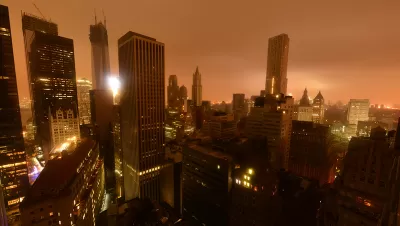Resiliency is rapidly influencing urban sustainability and hazard mitigation planning. Global Green has identified key questions and findings through Sustainable Neighborhood Assessments in four communities impacted by Hurricane Sandy.

Resiliency arrived with the alluring energy of a teenage pop star. Attractively fresh, full of untapped possibility, and seemingly fully grown, resiliency captured the attention of urbanists looking for the next sustainability. Closer inspection however, reveals that resiliency is deep in the midst of identity formation and figuring out how to relate to the seasoned grown ups of urban sustainability.
Global Green is currently working with a number of communities that are exploring how to relate resiliency to planning and disaster preparedness. Last year we completed Sustainable Neighborhood Assessments for Hoboken, New Jersey and Staten Island, New York. This week members of the Green Urbanism team, along with experts from the Agora Group and the US Green Building Council, are visiting Westerly, Rhode Island and Long Beach, New York. The communities were selected through a special solicitation related to sustainable rebuilding and resiliency that was coordinated by Global Green and the US EPA’s Office of Sustainable Communities.
These projects are providing opportunities to explore in depth a range of issues related to resiliency and climate adaptation, and to identify what specifically can be done in the short, medium, and long term. While each place is unique its geography, types of risk, and options for increasing resiliency, there are some common questions that apply.
What are the threats - storm surge, flooding, extended periods of hot or cold temperatures, fire, wind?
What are the risks - loss of life, property damage, ecosystem function, economic disruption?
What degree of resilience - one day, one week, one month, a year?
What strategies should be considered – protecting existing investments, accommodating some impacts, relocating out of harms way?
What tactics are viable – building codes, eminent domain, tax credits, assessment districts, infrastructure privatization?
Through our work in the Sandy impacted communities, combined with Southern California efforts conducted in collaboration with the Los Angeles Regional Collaborative for Climate Action, we’ve generated the following some initial findings regarding resiliency:
1. Adaptation is part of resiliency, not the other way around. Resiliency means to be able to bend but not break, or to withstand major system stress without complete failure. Adapting - by protecting, modifying, or relocating buildings and infrastructure that are at risk - is a critical component. But resiliency also means creating flexible and distributed delivery of critical services, combined with strengthening social networks so that neighbors can find and help each other.
2. Urbanism and resiliency make a good combo. Urban areas often feature inherent redundancies in systems and infrastructure and a physical form that enables more effective distribution of services in times of crisis, as compared to sprawling suburbs or remote rural areas.
3. Measures that provide benefits in non-crisis periods are more likely to be realized than those that are exclusively disaster related. A restored wetland that provides recreation space, captures and treats stormwater, and provides a storm surge barrier during extreme events has a much greater chance of happening than a single-purpose seawall. The same goes for solar panels that mitigate climate change by producing clean energy on a daily basis, while also charging a battery backup system able to provide power for medication and communication if the grid goes down.
4. Thinking needs to be both big and small. Modifying an historic building to accommodate occasional flooding could mean installing paperless drywall and moving the circuit box over a couple of weekends. Protecting a beachside neighborhood constructed on a sandbar requires coordination among local, regional, and state agencies to develop and implement the physical, ecological, and land use changes over multiple years.
As the discourse on resiliency matures, new ways to look holistically at persistent urban issues, including growth management, disaster preparedness, and hazard mitigation are emerging and a level of urgency that is often missing from discussions of sustainability comes forth. The challenge ahead is to weave resiliency into planning and green urbanism in way that leads to lasting changes in policy, urban form, and social networks that enhance our communities in both pre- and post- crisis conditions.

Maui's Vacation Rental Debate Turns Ugly
Verbal attacks, misinformation campaigns and fistfights plague a high-stakes debate to convert thousands of vacation rentals into long-term housing.

Planetizen Federal Action Tracker
A weekly monitor of how Trump’s orders and actions are impacting planners and planning in America.

San Francisco Suspends Traffic Calming Amidst Record Deaths
Citing “a challenging fiscal landscape,” the city will cease the program on the heels of 42 traffic deaths, including 24 pedestrians.

Defunct Pittsburgh Power Plant to Become Residential Tower
A decommissioned steam heat plant will be redeveloped into almost 100 affordable housing units.

Trump Prompts Restructuring of Transportation Research Board in “Unprecedented Overreach”
The TRB has eliminated more than half of its committees including those focused on climate, equity, and cities.

Amtrak Rolls Out New Orleans to Alabama “Mardi Gras” Train
The new service will operate morning and evening departures between Mobile and New Orleans.
Urban Design for Planners 1: Software Tools
This six-course series explores essential urban design concepts using open source software and equips planners with the tools they need to participate fully in the urban design process.
Planning for Universal Design
Learn the tools for implementing Universal Design in planning regulations.
Heyer Gruel & Associates PA
JM Goldson LLC
Custer County Colorado
City of Camden Redevelopment Agency
City of Astoria
Transportation Research & Education Center (TREC) at Portland State University
Jefferson Parish Government
Camden Redevelopment Agency
City of Claremont



























